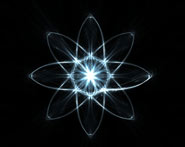


 الفيزياء الكلاسيكية
الفيزياء الكلاسيكية
 الكهربائية والمغناطيسية
الكهربائية والمغناطيسية
 علم البصريات
علم البصريات
 الفيزياء الحديثة
الفيزياء الحديثة
 النظرية النسبية
النظرية النسبية
 الفيزياء النووية
الفيزياء النووية
 فيزياء الحالة الصلبة
فيزياء الحالة الصلبة
 الليزر
الليزر
 علم الفلك
علم الفلك
 المجموعة الشمسية
المجموعة الشمسية
 الطاقة البديلة
الطاقة البديلة
 الفيزياء والعلوم الأخرى
الفيزياء والعلوم الأخرى
 مواضيع عامة في الفيزياء
مواضيع عامة في الفيزياء|
Read More
Date: 10-10-2016
Date: 20-10-2016
Date: 20-10-2016
|
Spontaneous Symmetry Breaking
Spontaneous symmetry breaking is a concept first introduced by W. Heisenberg in describing ferromagnetic materials. A ferromagnet has a perfect geometric symmetry until the Curie transition temperature is reached; then the material becomes magnetized and one particular direction of magnetization is chosen. The theory is symmetrical still, but the actual material is not. One can summarize the process by stating that microscopic events can have macroscopic consequences. Near the critical point of a phase transition, small, random fluctuations can grow to make their presence felt throughout the material. A few aligned spins can propagate their influence throughout the whole crystal, and the symmetry is broken.
Other examples are the Schrodinger equation and Maxwell’s equations. As successful in helping to describe nature as they have been, these equations have more symmetry than the underlying phenomena they describe. Interest in their symmetry-breaking applications has led to significant new insights into new connections between macroscopic and microscopic phenomena.
In particle physics, the spontaneous symmetry breaking is achieved by the Higgs mechanism. The Standard Model of Leptons and Quarks relies upon the Higgs particle to spontaneously break symmetry to provide three of the electroweak bosons with mass while leaving the photon massless. Simultaneously, all the leptons and quarks get their mass values. Moreover, the effect of the Higgs field is to provide a frame of reference in the vacuum for the isotopic spin directions that distinguish the particles of each grouping for example, neutrons from protons.
Is spontaneous symmetry breaking by the Higgs mechanism the only way to go? Are there other ways to spontaneously break symmetry to achieve the Standard Model of Leptons and Quarks?
Answer
Yes. At least two other methods can achieve the same symmetry-breaking result without requiring the Higgs particle. The Standard Model is described by its continuous gauge group SU(3)C × SU(2)W × U(1)Y. The simplest way of all is to spontaneously break this continuous group to a discrete symmetry subgroup of the continuous group SU(2). That is, the lepton and quark flavor eigenstates would be associated with finite rotational subgroups of SU(2) instead of the continuous group. An analogy from geometry would be to begin with a sphere and then symmetry break to a regular tetrahedron, or a regular octahedron, or a regular icosahedron. Reconciling discreteness with the continuous symmetry group U(1) of quantum electrodynamics may be a problem, however, where phases are assumed to vary continuously. Another symmetry-breaking approach is the quark condensate method, which also does not require a Higgs particle.
At present, no Higgs particle has been detected at the accelerators, even though its mass is expected to be below 200 GeV/c2, within the energy range of the large accelerators. Of course, the decay of such a Higgs particle is a flavor- changing neutral current weak decay, which means that its decay rate is severely suppressed, so only a few Higgs decays would have been detected among the particle debris so far. When the Large Hadron Collider comes online in 2005 or later there should be copious production of the Higgs particle if this mechanism is truly the source of symmetry breaking and the particle masses. If the Higgs particle does not show up, then spontaneous symmetry breaking to a discrete group remains an alternative possibility.



|
|
|
|
كل ما تود معرفته عن أهم فيتامين لسلامة الدماغ والأعصاب
|
|
|
|
|
|
|
ماذا سيحصل للأرض إذا تغير شكل نواتها؟
|
|
|
|
|
|
|
بالتعاون مع العتبة العباسية مهرجان الشهادة الرابع عشر يشهد انعقاد مؤتمر العشائر في واسط
|
|
|